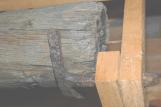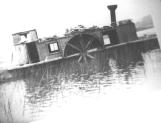2
Logging was a major industry in the late 1800's and early 1900's that developed from the copper mining in the area. The mining companies required lumber to build company buildings and homes for their miners and their families. Wharfs had to be built to accommodate the shipping industry, providing transportation of supplies and people to Bruce Mines. The town itself required schools, churches, and a business infrastructure.Photo courtesy of the Bruce Mines Museum.
4
Beams to shore up the walls of the mine were also necessary. The miners used a "bullnose" to attach one end of the beam to the mine wall and shimmed the other end to ensure a snug fit. This would assist miners working at different levels, as well as support the wall of the mine.This original bullnose is attached to a wood frame for display purposes only.
5
Recreated head frame at the Simpson Mine Shaft.1992
Simpson Mine Shaft, Bruce Mines, Ontario, Canada

6
Headframes were built at the top of the shafts allowing the ore, and when the mine was deep enough, miners, to be brought to the surface in buckets called "kibble buckets".8
Logs were laid across the mining trench and covered with earth and stones to form a solid ceiling to the mine, protecting the miners from the elements, and allowing them to work year round.10
There were several lumberjack crews working in the area. Logs were moved across Ottertail Lake and down the Thessalon River to the sawmills.Photo courtesy of Merritt Strum.
12
Ottertail Lake created a problem for the "river drives", moving the logs via waterways to the mills, since it was a very shallow lake. Charles Hunt purchased an old tugboat, called the Alligator, from W.R. Smyth, to haul the booms across the lake. The booms would then be manoeuvred down the Thessalon River.Photo courtesy of Ian West.
14
This is a corduroy tote road in the Blind River area, used to access lumber camps. These roads were built by laying logs side by side and were very effective for use over swampy areas. In the Bruce Mines area, Carter Road in Plummer Township, was originally a corduroy road, but has been resurfaced for use today.Photograph courtesy of the Ontario Ministry of Northern Development and Mines.
© Queen's Printer for Ontario, 1907. Reproduced with permission.





